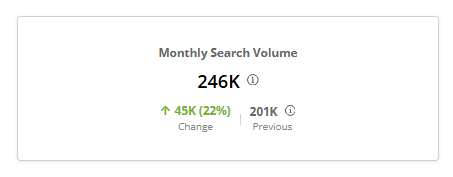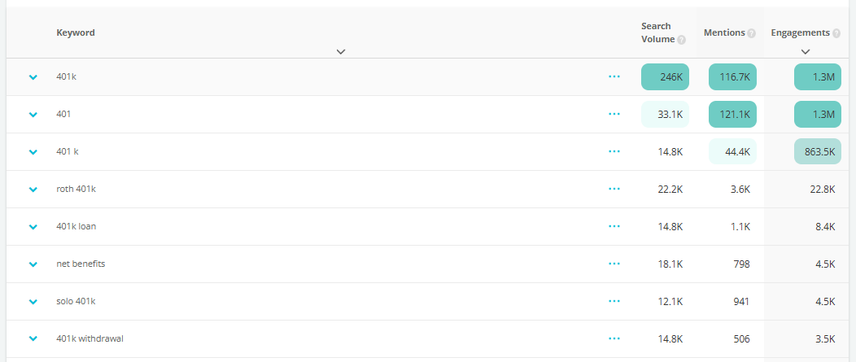Behind Organic Traffic Fluctuations: The Role of Search Demand
- Thought Leadership
- By Rachel Schardt
- 6 minutes read
Traffic down? Learn how search demand trends shape organic traffic and the importance of aligning SEO with your overarching marketing strategies.
“Why is traffic down?” - a dreaded question for any SEO or Marketing Leader.
This usually leads to technical audits, rank change analyses, or trying to understand how and why the latest algorithm update impacted your site. While those are certainly metrics to look into, what’s frequently overlooked in these analyses is the underlying trend of demand.
For instance, misattributing traffic and sales decline to “SEO issues” might overlook larger demand shifts, or a gap in other marketing strategies.
The Influence of Brand Demand on Organic Traffic and Sales
An increase in organic traffic and sales is typically seen as the equivalent to successful SEO strategies, but even the best sites and SEO teams can struggle to maintain organic performance if demand is declining for previous top traffic driving terms. And while both non-branded and branded demand can fluctuate, we often see the steepest changes in branded search demand. On top of that, a recent study done by SparkToro , shows that “just over 44% of Google searches are for branded terms”.
Brand demand can be influenced by macroeconomic conditions, changes in consumer behavior, shifts in market competition, or a change in other marketing efforts. For example, if you run a superbowl ad, evaluating if brand demand increased in the month following would indicate a successful campaign. Alternatively, if other marketing efforts have been reduced, that may correlate to a decline in brand demand.
Marketing leaders must recognize that driving demand is not the role of the SEO team. While SEO can optimize visibility and ensure content ranks well, it cannot create consumer interest where it does not exist. Brand demand in particular must be driven by broader business strategies, including marketing campaigns, product innovation, and customer engagement efforts.
Organic search is best understood in the context of digital presence. Are you present when people are looking for you specifically in branded search or the things you do and problems you solve with generic queries? It’s helpful to be mindful of this when running a campaign and especially when communicating about the state of organic search with stakeholders who aren’t intimately familiar with SEO.
Optimization can’t create market demand. So, when investigating traffic drops, it’s important to first discover what the demand conditions may be. Your technical and on-page optimizations may be on point, but if fewer people are searching, it doesn’t matter how available you are. There’s just a smaller audience.
A Look at Driving Brand Demand
To better understand some of these trends, we took a look at brand demand data for Fortune 500 companies. We looked at both the monthly search volume, as well as the average monthly search volume, using data from Conductor.
One of the standout brands was Northwestern Mutual , who has seen a significant increase in brand demand since 2022. Isolating into year-over-year, with Keyword Details in Conductor, we see an increase of 22% YoY. 

So how did Northwestern Mutual increase their brand demand by 22% in the last year?
Based on data from SocialBlade , Northwestern Mutual has significantly grown their social media presence. Looking at September year-over-year, they’ve increased their YouTube video views by about 32%, and their total YouTube subscribers by about 11%. They’ve also seen a steady increase to their other social channels, with their current Instagram follower count at 30.6K and their TikTok follower count at 71.7K.

Image from Social Blade
While we can’t analyze every strategy the team at Northwestern utilized, it’s pretty clear they’re right in line with the insights FINRA published in their 2022 investor report stating that “the majority of young investors use social media as a source of investment information,” and that “YouTube is the most popular social media channel for investment information.”
Others in the financial space who are seeing traffic and demand declines for branded terms, might look at diversifying their digital strategy to include YouTube, and other social channels.
So, what now?
Reporting for SEO Teams
We strongly encourage teams to include demand analysis in their reporting.
This involves:
- Using tools like Conductor to track search demand changes.
- Monitoring competitors branded demand for benchmarking.
- Breaking out SEO reporting for branded and non-branded traffic.

For any topic, there is finite and calculable demand. This generic and branded demand fluctuates based on many factors, from macroeconomic forces to marketing campaigns. Benchmarking against your direct competition level sets performance, exposes content gaps and highlights strengths to double down on.
Determine how to dominate your market by knowing exactly how much of the organic pie you own. Effective executive reporting should show how much of the total addressable market your site has in SERP impressions and traffic.
Take mobile phones, for example. I'd expect Apple's brand demand to surge each fall during their new releases, with Google and Samsung perhaps dipping slightly. Overall, the smartphone market may be increasing, or steady. The only way to tell would be to have a wide yet focused set of KWs around mobile phones and to track how that changes through time, and then also to look at the brand terms like iPhone, Pixel, and Galaxy. Google Trends is overly simplistic.
Future Strategy for SEO Teams
Many companies have relied heavily on a branded SEO strategy, focusing on capturing traffic from search queries that include their brand or unique product names. And while branded SEO is important, it does little to attract new audiences, drive incremental growth, or help you combat declines in brand demand.
Businesses need to explore and invest in SEO opportunities that target non-branded search terms related to their industry, products, and services. (Non-branded accounts for about 56% of all Google searches according to SparkToro’s recent study.)
Additionally, SEO teams should partner closely with other departments involved in demand generation, such as marketing, sales, and product development, to align on campaigns that drive awareness and interest. Collaboration with these teams ensures that SEO efforts are supported by larger initiatives designed to increase consumer demand and expand reach beyond the existing customer base.
We recommend:
- Exploring non-branded opportunities.
- Partnering closely with other marketing teams to collaborate on overarching digital strategy.
- Create custom annotations in the Conductor Pages feature to mark key brand campaigns to identify potential correlation between organic traffic and brand marketing.
- Using Conductor to identify emerging social trends in Explorer for site content.

Final Thoughts
By broadening the scope of analysis to include demand trends, businesses can not only attribute declines or growth in organic performance accurately, but can make more informed decisions about their overall strategy. Increasing collaboration and creating a holistic digital strategy is your best bet to ensure success in our ever evolving digital landscape.







